If you've ever played a Takamine guitar, you know the iconic Japanese brand creates instruments that exude heritage and craftsmanship.
The P4DC is an outstanding dreadnought acoustic-electric guitar that carefully merges tradition and innovation. It combines unique guitar-making traditions with an innovative preamp system to create a versatile, uncompromising acoustic instrument.
From hard strumming to nuanced fingerstyle, the Takamine P4DC can excel in every context and across styles, so let's analyze and praise this masterpiece together!
Takamine P4DC Overview
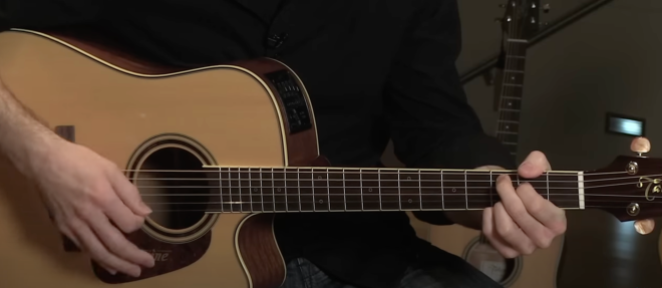
Regarded as one of the best high-end acoustic guitars in the world, the Takamine P4DC is an acoustic-electric guitar that offers impressive playability and sound quality.
The P4DC combines high-quality tonewoods, including a resonant solid spruce top and solid sapele on the back and sides. For the fingerboard, the P4DC uses rosewood and mahogany on the neck. This combination results in more chime, glitter, and superior clarity.
Aside from the excellent wood craftsmanship, the Takamine P4DC also shines in its featured electronics. Takamine’s Palathetic under-saddle pickups combined with the CTP-3 Cool Tube preamp allow the Takamine P4DC to create a warm and vibrant sound regardless of the room it's in.
The natural bone nut and split bone saddle provide the Takamine P4DC with impressive tuning stability, sustain, and consistent playability throughout the fretboard.
Specs
- Body Style: Dreadnought
- Cutaway: Venetian
- Top wood: Solid spruce top
- Back wood: Solid sapele back
- Sides wood: Solid Sapele sides
- Neck wood/profile: mahogany asymmetric neck
- Fingerboard wood: Rosewood
- Nut width: 42.5mm (1.675”) natural bone
- Finish: Natural gloss
- Bracing: X scalloped
- Electronics: CTP-3 and Palathetic pickups
Why I Like It
- The CTP-3 plus Takamine’s unique Palathetic pickup combination creates a beautiful resonant sound.
- Warm and enveloping sound texture.
- Comfortable neck profile.
- Beautiful design.
What I Think Could Be Improved
- The action is high but can be adjusted.
- The dot in dot inlays can be hard to see.
Average Rating: 4.5
Takamine P4DC Reviewed
Guitar Design: 4/5
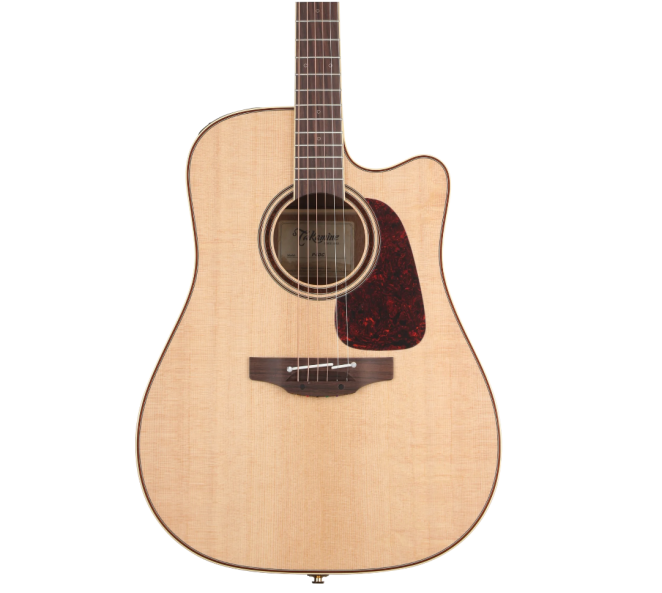
The Takamine P4DC is a beauty to look at. The familiar dreadnought cutaway, the most popular body shape over the past half-century, feels like a perfectly natural curve for the P4DC, making it ideal also for beginners who want a standard shape to start their music journey.
Built with a solid spruce top, solid Sapele back and sides, mahogany on the neck, and a rosewood fingerboard, the Takamine P4DC's tonewoods are carefully selected for their resonance, longevity, and timeless appeal.
Fittingly, on my test run, I found the P4DC dreadnought body shape produced loud and strong low end, giving a balanced and versatile tone for any playstyle and musical genre. It responded equally well to gentle fingerpicking, aggressive strumming, and picked single-note runs with a beautiful rich tone and impressive resonance.
Classy gold tuners with amber buttons, elegant ivory body binding combined with dark wood purfling, a captivating red tortoise pickguard, and a gloss natural finish complement the Takamine P4DC's majestic design.
One thing that may not be of everyone's liking is the dot-in-dot inlays: they look good and fit the overall design, but I find that full-color dots are easier to see. If you're like me and need to take a peek at your fretboard from time to time, you might find these inlays to be less than ideal.
Asymmetrical Neck Profile: 4/5
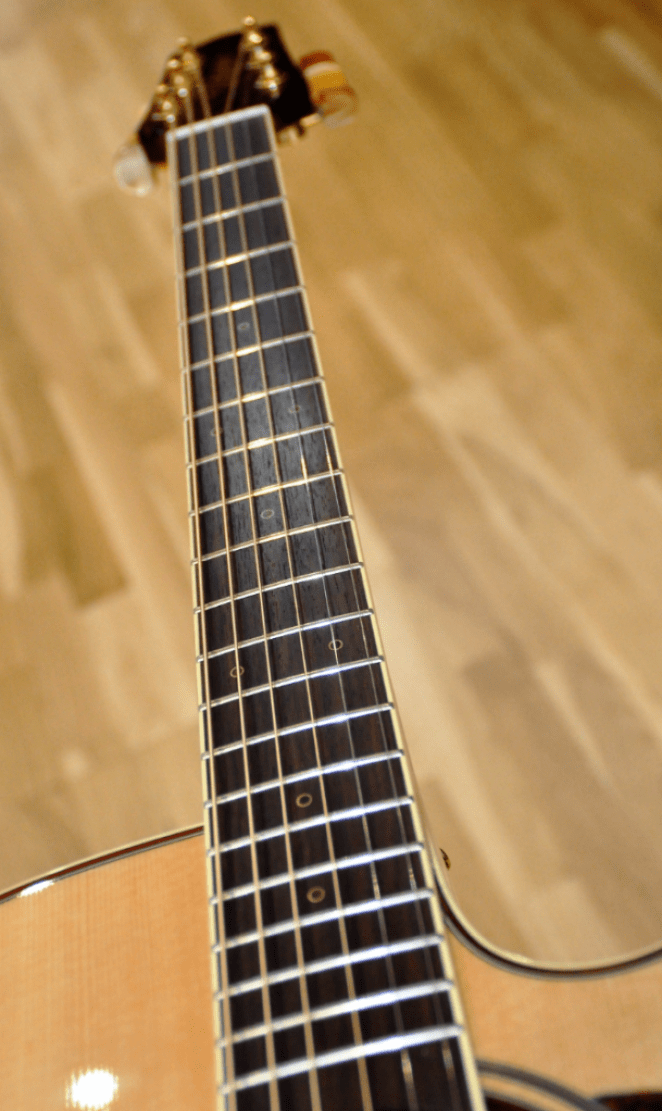
The Takamine P4DC's mahogany neck is asymmetrical: it feels slim, extremely smooth, and comfortable to play when you slide your hand across the fingerboard. I found barre chords to be particularly easy to play, which, as we know, are punishing on some fatter-necked acoustics.
Plus, the asymmetrical necks in Takamine guitars minimize the movement of the wrist, which really does help preserve energy even after performing or practicing for hours.
That said, the asymmetrical shape might not be for everyone. If you’ve never played an acoustic guitar with an asymmetrical neck profile, you might want to try one (and I mean for days) before buying the Takamine P4DC.
Nut Width: 3/5
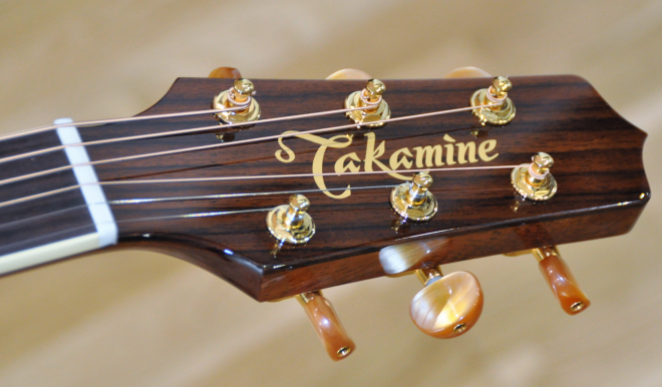
The Takamine P4DC nut width is 42.5mm, or around 1.675", which feels slightly narrow for guitarists accustomed to Martin guitars, for example.
The nut is made of natural bone material, which has its obvious benefits but can also result in a slightly unpredictable nut position. While the nut width cannot be changed, you do have the option to adjust the nut to lower the action for a more comfortable playing experience.
Split Saddle: 5/5

The split saddle is a unique feature in many Takamine acoustic guitars.
Splitting the saddle right between the G and B strings tackles the common issue of intonation between the strings in the lower and higher registers: each saddle has its own angles, allowing your guitar to have more accurate intonation and stay in tune for longer. This is an excellent "trick" that makes your guitar more reliable and performing.
Pinless Rosewood Bridge: 5/5
All models of the Takamine Pro Series guitars feature a pin-less rosewood bridge. Takamine gets rid of the tiny pieces in their entirety to leave a cleaner bridge that makes it easier to change the strings. So, no more losing the pins on stage!
Palathetic Under-Saddle Pickup: 5/5
Takamine's unique Palathetic pickup is the secret component responsible for this acoustic-electric guitar's excellent amplified sound. These pickups are located under the saddle to directly pick up the string vibration, creating a more natural and authentic acoustic sound for the Takamine P4DC.
But that’s not all. The Palathetic pickups system provides a balanced frequency response and helps minimize feedback when connected to a guitar amp. When paired with onboard preamps like the CTP-3, you can shape your sound for a peerless amplified response.
I found the Palathetic system in our P4DC to be particularly effective for more percussive techniques, making this guitar ideal for solo acoustic performers who make use of their guitar for all kinds of sounds.
CTP-3 CoolTube Preamps: 5/5
The CTP-3 CoolTube Preamps are another highlight of the Takamine P4DC. These preamps offer a versatile system with few controls that are easy to operate for beginners, yet they can greatly enhance the beauty and articulation of the P4DC.
The tuner button gives you access to the onboard chromatic tuner, which is good enough for everyday tuning. I loved the feature that allows you to tune your total guitar in silence by pressing the tuner button twice – perfect for tuning onstage without scaring away your audience.
A three-band EQ controls the tonal balance of the bass, mid, and treble frequencies. A notch filter finds and cuts out problematic frequencies, so feedback isn't ever a problem. Additionally, the CTP-3 allows you to connect an AUX pickup.
The P4DC strives to offer everything a guitarist needs to perform stress-free, making it an amazing guitar for gigging professional musicians who want it all.
Sound Quality: 5/5
Because of the combination of the tonewoods used, the custom design of the Palathetic pickups, and the CTP-3 preamp system, the Takamine P4DC premium materials pay off with exceptional sound quality you won't easily find at this price.
The resonance and projection from the Takamine P4DC are the result of a collective effort: from the solid spruce top, to the sapele back and sides, and the X-scalloped bracing, this high-quality guitar brings to life a level of natural acoustics that work magnificently with any playing style.
The Takamine P4DC's pickups amplify its already refined acoustic sound, while the CTP-3 preamp adds an extra layer of clarity and warmth to your performance.
Its exceptional sound quality works well with hard strumming, complex single-note lines, and intricate picking without breaking a sweat, providing a consistently rich and immersive sound.
All in all, the P4DC's tonal capabilities are unique at its price point and truly impressive.
Things to Consider When Buying a High-End Acoustic Electric Guitar
Buying an acoustic-electric guitar can be challenging, especially when you're gearing up to break the bank on a high-end professional instrument.
Acoustic guitars with onboard electronics are generally the best option for live performers as they allow you to amplify the sound on stage without using external mics.
They are also better suited for recording singer-songwriters who prefer acoustic tones but also like to tweak the tonality with the onboard preamp and three-band EQ.
Here are the things I typically consider when testing premium acoustic guitars, and that you should consider as well in your search.
Body Type
Various body shapes for acoustic guitars produce different sounds and tonality. You should research the other body types and consider those that may suit you.
Here are a few body types available in acoustic-electric guitars:
- Dreadnought: The most popular body shapes in acoustic guitars. This body type is large, deep, and produces a strop bass response. It can support voices perfectly thanks to its lower registers. It’s versatile and suitable for various music styles.
- Concert: It has a narrow waist and is balanced in tone and response. It is suited for fingerpicking-style guitarists.
- Parlor: This lightweight and compact body guitar is easy to hold due to its small size. It's ideal for fingerstyle and folk music.
- Grand Auditorium: This body type is a mid-size guitar with balance on treble and bass. It's suitable for both fingerstyle and strumming.
- Jumbo: They’re larger guitars with a strong low end. They are mostly used for strumming and country music.
Tonewood
The wood used to construct the acoustic guitar is called tonewood. Guitars usually combine materials for the top, back, and sides, influencing the tone. Spruce, rosewood, mahogany maple, and cedar are common wood materials, each with its unique sonic characteristics.
Learn more about the different tonewoods and their characteristics in our guide to the best high-end acoustic guitars.
Playability
An acoustic guitar with good playability will feel comfortable playing without causing too much tension and fatigue. When testing acoustic guitars, I typically pay attention to the action, the neck profile, and the fretboard.
Your position when playing, the size of your hands, your playing style—everything can define whether a guitar is right for you, and there's no other way to find out than through firsthand experience.
Electronics
The electronics on your acoustic guitar affect the sound of your music. The benefit of electric acoustic guitars over acoustic guitars is the possibility of connecting your guitar to an amp to perform live, record, and shape your tone with the built-in EQ without an external microphone and equipment.
Here is what I typically focus on when testing acoustic-electric guitars:
- Pickup system: Acoustic guitar pickups are essential to amplify your sound. You can find different types of pickups: microphone pickups, piezo, magnetic, under-saddle pickups, transducers, and more. Each pickup type has its unique features and tonality.
- Preamps: The onboard preamps control the volume and shape the tone of your guitar. It could include a single-tone knob or a three-band EQ. Occasionally, they include a built-in tuner, too.
- Feedback filter: When acoustic-electric guitars are amplified, feedback can affect your performance. Some guitars include a notch filter or phase switches to minimize the feedback.
- Battery: Some onboard preamps are battery-powered. Consider the type of battery required and if it's easy to replace, and look at rechargeable options if your manufacturer recommends them.
Build Quality
Looks are important, but the build quality of your guitar will determine not only its durability and resistance but also the quality of its sound. If you invest in a high-end acoustic guitar, get one designed with material that's made to last, possibly by a brand or luthier renowned for their craft.
Guitar Brands
Buying an acoustic guitar from a reputable guitar brand will make you sleep better at night. Guitar brands like Takamine, Taylor, Gibson, Yamaha, and Martin are known for making the best acoustic guitars.
Accessories
People tend to forget the accessories needed to play the guitar. Once you learn to play and start to gig, you will realize that many things are essential, such as extra guitar picks, strings, straps, a capo, a tuner, a case or carrying bag, amps, cables, cleaning cloths, and other maintenance products.
Some guitars come with tuners, a carrying bag, or a strap, so you can take this opportunity to save a few dollars and upgrade the rest of your gear, if you need to.
Budget
The price range for acoustic-electric guitars is extremely wide: there are budget-friendly acoustic options you can get for less than $100 and high-end models that cost thousands of dollars. In between these two extremes, there are endless options.
How much you're willing to spend will significantly narrow down your options, so it's always good practice to identify how much you're willing to spend on your new guitar.
Spending more doesn't necessarily mean you'll sound better: sometimes it's all about the feeling between the guitarist and the instrument. A friend of mine, an exceptional guitarist, recently went on tour with a Yamaha Pacifica, and had a blast. If you constantly hone your craft, most guitars will sound great in your hands.
Alternatives to the Takamine P4DC
The Takamine P4DC might not be suitable for everyone, so I made this list with a few alternatives that still offer high-quality sound, are in the price range, and have similar features.
Takamine P4DC Vs Martin D-28
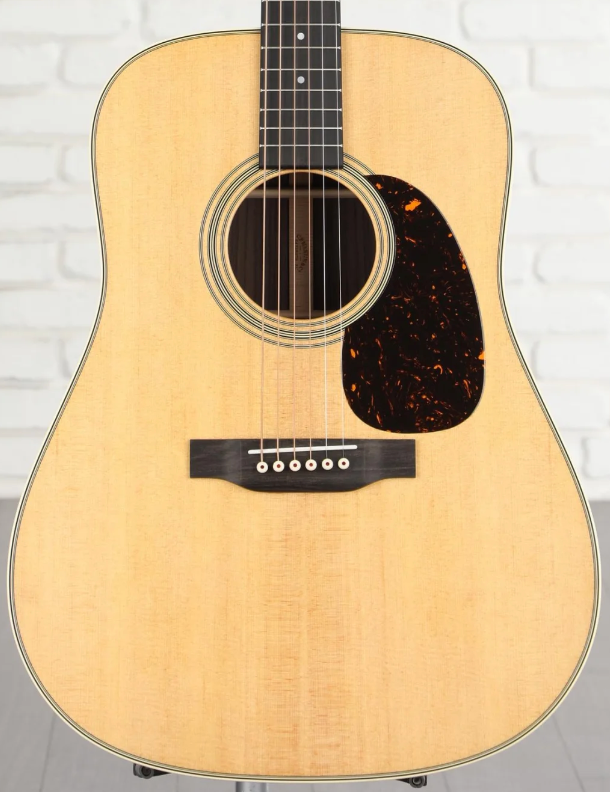
The Martin D-28 is a popular guitar with a dreadnought body type, spruce top, rosewood on the back and sides, and ebony on the fingerboard.
Thanks to the combination of these tonewoods, Martin's tone is iconic and beloved by professional guitarists. In my opinion, the modified low oval neck shape could feel more comfortable than the asymmetrical one offered by the P4DC.
Check out our full review of the Martin D-28 here.
Takamine P4DC Vs Gibson SJ-200
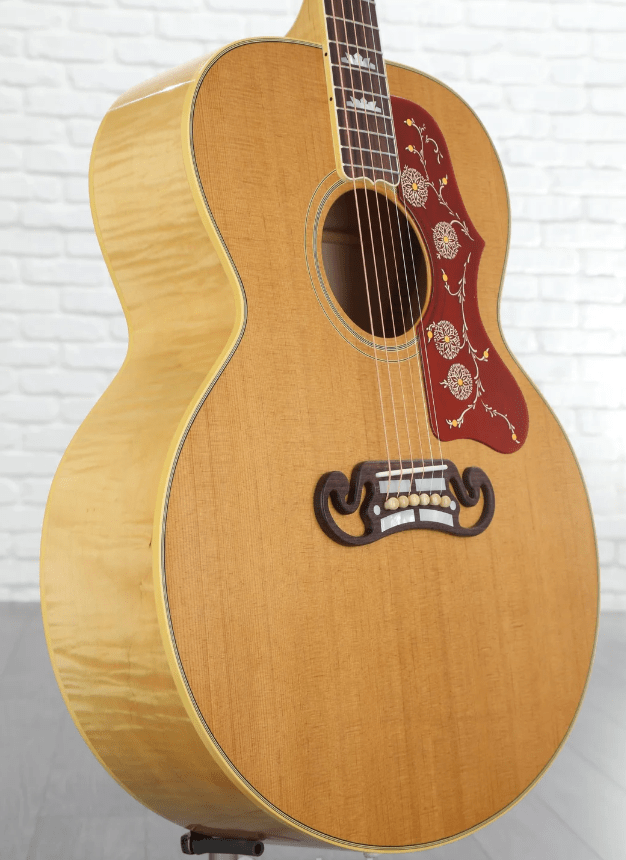
The Gibson SJ-200 is a super jumbo body shape guitar. It's one of the most famous guitars in the world but it's quite an investment (over $5000). It's built with Sitka spruce and flamed maple back and sides. The round neck shape is comfortable and includes studio-quality LR Baggs VTC electronics.
While pricey, the Gibson SJ-200 is a legendary guitar used by countless artists across genres, so if you're serious about your craft, consider investing in this exceptional model.
Check out our full Gibson SJ-200 Review here.
Takamine P4DC Vs Eastman E8D
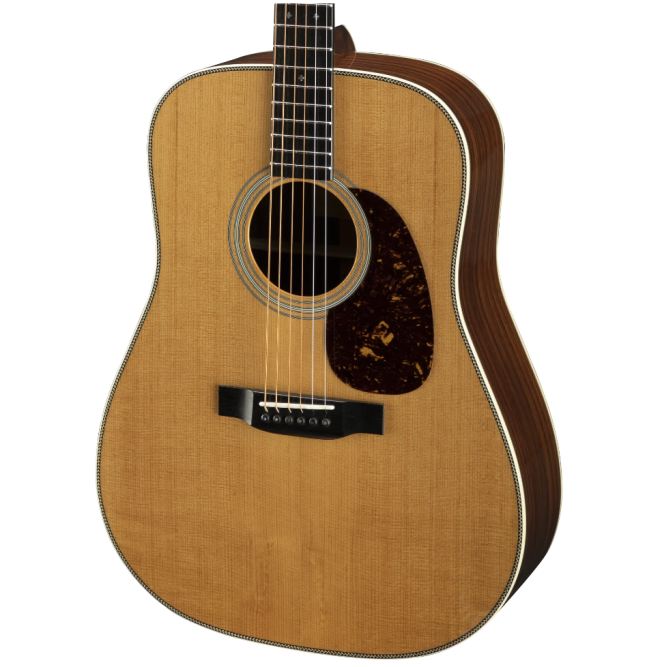
The Eastman E8D is a dreadnought guitar with a spruce top, rosewood back and sides, mahogany neck, and ebony Fingerboard. It's a good alternative for beginners and guitar players who want an acoustic guitar with a rich, warm sound and solid wood construction without spending a fortune.
Conclusion
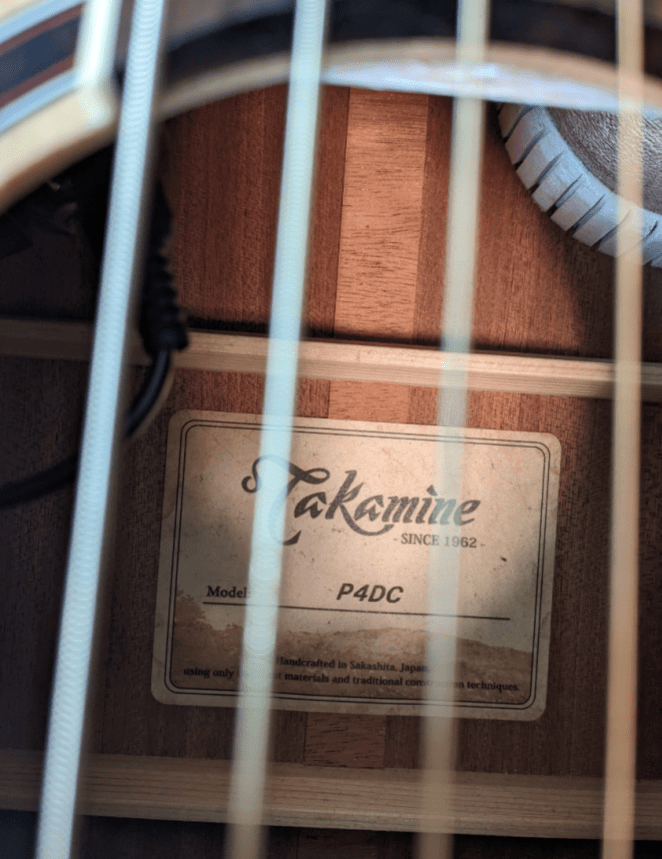
I might have said this already, but I think the Takamine P4DC is an acoustic-electric guitar that's reasonably priced and sounds fabulous. It’s a road warrior that can accompany you on the road for years to come, and will always be up to the task.
It features high-end construction with exclusive Takamine features such as a Palathetic Under-Saddle Pickup, CTP-3 preamp system, and split sadder; all of this makes it an excellent option for both beginners and seasoned guitarists, but do make sure you're comfortable playing with an asymmetrical neck profile.
But if Takamine's not your style, there are many valid alternatives at different price points.
If you're looking for something superior in sound and quality (and price), you can't go wrong with the SJ-200, a guitar used by the likes of Neil Young, Pete Townsend and Bruce Springsteen.
Alternatively, the Martin D-28 will give you the iconic Martin tone and a more comfortable neck, but again, the price is way higher. If your budget is just above $1000, the Eastman E8D is definitely a valid alternative to the P4DC, so do check it out.
Have fun!
Images courtesy of Sweetwater and Takamine.
